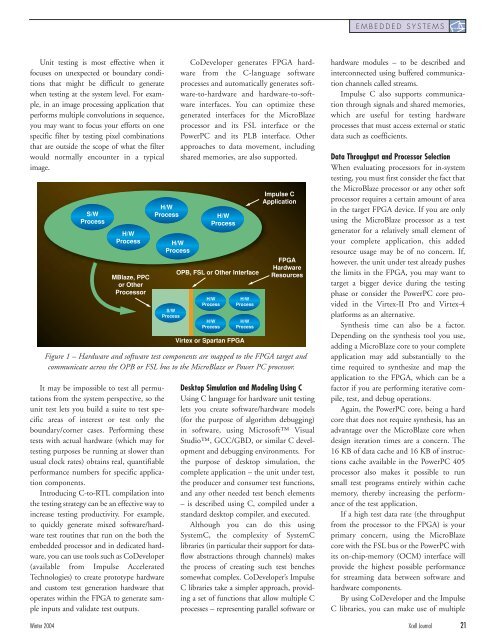Xcell Journal: The authoritative journal for programmable ... - Xilinx
Xcell Journal: The authoritative journal for programmable ... - Xilinx
Xcell Journal: The authoritative journal for programmable ... - Xilinx
Create successful ePaper yourself
Turn your PDF publications into a flip-book with our unique Google optimized e-Paper software.
Unit testing is most effective when it<br />
focuses on unexpected or boundary conditions<br />
that might be difficult to generate<br />
when testing at the system level. For example,<br />
in an image processing application that<br />
per<strong>for</strong>ms multiple convolutions in sequence,<br />
you may want to focus your ef<strong>for</strong>ts on one<br />
specific filter by testing pixel combinations<br />
that are outside the scope of what the filter<br />
would normally encounter in a typical<br />
image.<br />
S/W<br />
Process<br />
H/W<br />
Process<br />
MBlaze, PPC<br />
or Other<br />
Processor<br />
It may be impossible to test all permutations<br />
from the system perspective, so the<br />
unit test lets you build a suite to test specific<br />
areas of interest or test only the<br />
boundary/corner cases. Per<strong>for</strong>ming these<br />
tests with actual hardware (which may <strong>for</strong><br />
testing purposes be running at slower than<br />
usual clock rates) obtains real, quantifiable<br />
per<strong>for</strong>mance numbers <strong>for</strong> specific application<br />
components.<br />
Introducing C-to-RTL compilation into<br />
the testing strategy can be an effective way to<br />
increase testing productivity. For example,<br />
to quickly generate mixed software/hardware<br />
test routines that run on the both the<br />
embedded processor and in dedicated hardware,<br />
you can use tools such as CoDeveloper<br />
(available from Impulse Accelerated<br />
Technologies) to create prototype hardware<br />
and custom test generation hardware that<br />
operates within the FPGA to generate sample<br />
inputs and validate test outputs.<br />
H/W<br />
Process<br />
H/W<br />
Process<br />
S/W<br />
Process<br />
CoDeveloper generates FPGA hardware<br />
from the C-language software<br />
processes and automatically generates software-to-hardware<br />
and hardware-to-software<br />
interfaces. You can optimize these<br />
generated interfaces <strong>for</strong> the MicroBlaze<br />
processor and its FSL interface or the<br />
PowerPC and its PLB interface. Other<br />
approaches to data movement, including<br />
shared memories, are also supported.<br />
H/W<br />
Process<br />
OPB, FSL or Other Interface<br />
H/W<br />
Process<br />
H/W<br />
Process<br />
Virtex or Spartan FPGA<br />
H/W<br />
Process<br />
H/W<br />
Process<br />
Impulse C<br />
Application<br />
FPGA<br />
Hardware<br />
Resources<br />
Figure 1 – Hardware and software test components are mapped to the FPGA target and<br />
communicate across the OPB or FSL bus to the MicroBlaze or Power PC processor.<br />
Desktop Simulation and Modeling Using C<br />
Using C language <strong>for</strong> hardware unit testing<br />
lets you create software/hardware models<br />
(<strong>for</strong> the purpose of algorithm debugging)<br />
in software, using Microsoft Visual<br />
Studio, GCC/GBD, or similar C development<br />
and debugging environments. For<br />
the purpose of desktop simulation, the<br />
complete application – the unit under test,<br />
the producer and consumer test functions,<br />
and any other needed test bench elements<br />
– is described using C, compiled under a<br />
standard desktop compiler, and executed.<br />
Although you can do this using<br />
SystemC, the complexity of SystemC<br />
libraries (in particular their support <strong>for</strong> dataflow<br />
abstractions through channels) makes<br />
the process of creating such test benches<br />
somewhat complex. CoDeveloper’s Impulse<br />
C libraries take a simpler approach, providing<br />
a set of functions that allow multiple C<br />
processes – representing parallel software or<br />
EMBEDDED SYSTEMS<br />
hardware modules – to be described and<br />
interconnected using buffered communication<br />
channels called streams.<br />
Impulse C also supports communication<br />
through signals and shared memories,<br />
which are useful <strong>for</strong> testing hardware<br />
processes that must access external or static<br />
data such as coefficients.<br />
Data Throughput and Processor Selection<br />
When evaluating processors <strong>for</strong> in-system<br />
testing, you must first consider the fact that<br />
the MicroBlaze processor or any other soft<br />
processor requires a certain amount of area<br />
in the target FPGA device. If you are only<br />
using the MicroBlaze processor as a test<br />
generator <strong>for</strong> a relatively small element of<br />
your complete application, this added<br />
resource usage may be of no concern. If,<br />
however, the unit under test already pushes<br />
the limits in the FPGA, you may want to<br />
target a bigger device during the testing<br />
phase or consider the PowerPC core provided<br />
in the Virtex-II Pro and Virtex-4<br />
plat<strong>for</strong>ms as an alternative.<br />
Synthesis time can also be a factor.<br />
Depending on the synthesis tool you use,<br />
adding a MicroBlaze core to your complete<br />
application may add substantially to the<br />
time required to synthesize and map the<br />
application to the FPGA, which can be a<br />
factor if you are per<strong>for</strong>ming iterative compile,<br />
test, and debug operations.<br />
Again, the PowerPC core, being a hard<br />
core that does not require synthesis, has an<br />
advantage over the MicroBlaze core when<br />
design iteration times are a concern. <strong>The</strong><br />
16 KB of data cache and 16 KB of instructions<br />
cache available in the PowerPC 405<br />
processor also makes it possible to run<br />
small test programs entirely within cache<br />
memory, thereby increasing the per<strong>for</strong>mance<br />
of the test application.<br />
If a high test data rate (the throughput<br />
from the processor to the FPGA) is your<br />
primary concern, using the MicroBlaze<br />
core with the FSL bus or the PowerPC with<br />
its on-chip-memory (OCM) interface will<br />
provide the highest possible per<strong>for</strong>mance<br />
<strong>for</strong> streaming data between software and<br />
hardware components.<br />
By using CoDeveloper and the Impulse<br />
C libraries, you can make use of multiple<br />
Winter 2004 <strong>Xcell</strong> <strong>Journal</strong> 21

















